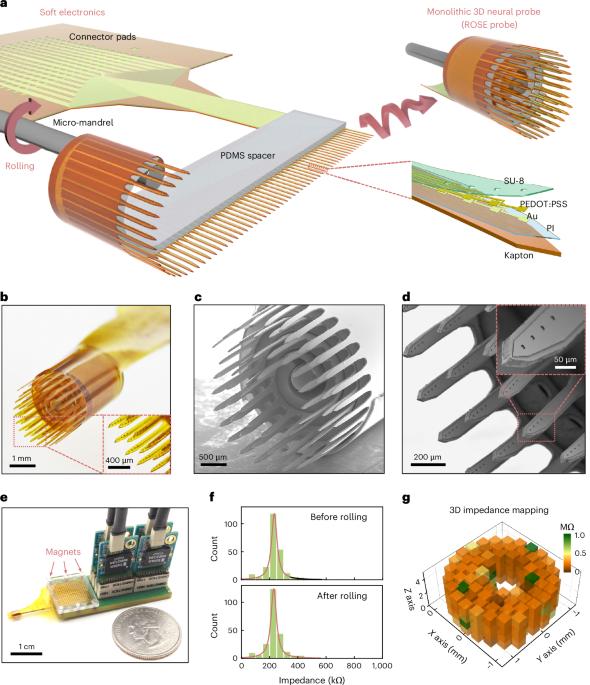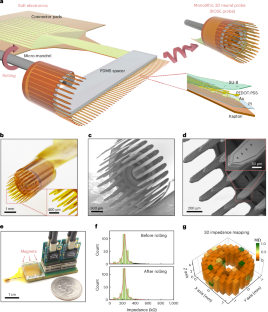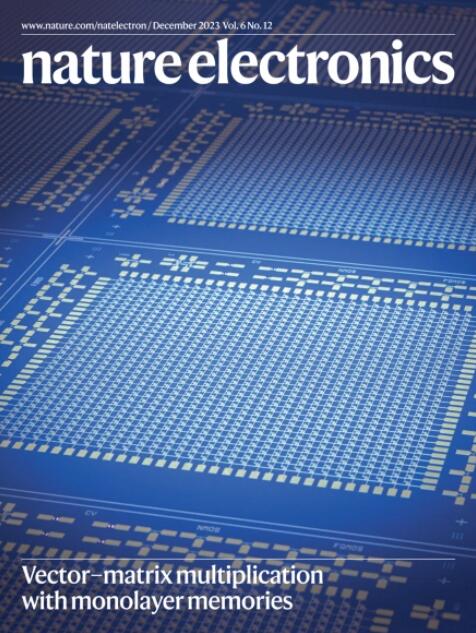软电子产品确定性轧制的单片三维神经探针
IF 40.9
1区 工程技术
Q1 ENGINEERING, ELECTRICAL & ELECTRONIC
引用次数: 0
摘要
认知和行为依赖于分布在三维空间的神经回路的协调活动。然而,由于平面半导体制造工艺的限制,用于记录大脑神经活动的典型探针仅限于二维界面。在这里,我们报告了一种软电子滚制方法来创建具有高可扩展性和设计灵活性的单片三维(3D)神经探针。与以往的堆叠或组装方法相比,该方法利用柔性电极的柔软性,直接将平面器件转变为三维探头。电极柄最初在一个平面上制造,然后连接到一个柔性垫片上。通过改变平面设计的特征,如杆距和间隔层厚度,该设备可以确定地轧制成包含数百个电极的多功能3D探头设计。利用该系统,我们在啮齿类动物和非人类灵长类动物模型中展示了单单位脉冲记录。我们还表明,该探针可以提供类似显微镜的啮齿动物视觉皮层中spike活动的三维时空映射,具有长达五周的记录稳定性和有希望的视觉方向3D解码性能。本文章由计算机程序翻译,如有差异,请以英文原文为准。


Monolithic three-dimensional neural probes from deterministic rolling of soft electronics
Cognition and behaviour rely on coordinated activity from neural circuits distributed across three dimensions. However, typical probes for recording neural activity in the brain are limited to two-dimensional interfacing due to the planar semiconductor fabrication process. Here we report a rolling-of-soft-electronics approach to create monolithic three-dimensional (3D) neural probes with high scalability and design flexibility. Compared with previous stacking or assembly methods, the approach directly transforms a planar device into a 3D probe by leveraging the softness of flexible electrodes. The electrode shanks are initially fabricated in a single plane and then connected to a flexible spacer. By varying the features of planar design, such as shank pitch and spacer layer thickness, the device can then be deterministically rolled into versatile 3D probe designs containing hundreds of electrodes. With the system, we demonstrate single-unit spike recording in vivo in rodent and non-human primate models. We also show that the probe can provide microscopy-like 3D spatiotemporal mapping of spike activities in the rodent visual cortex, with five-week-long recording stability and promising 3D decoding performance of visual orientation. Soft electronic probes for measuring neural activity can be made scalably in an initially planar form and turned into various three-dimensional geometries through a controlled rolling method.
求助全文
通过发布文献求助,成功后即可免费获取论文全文。
去求助
来源期刊

Nature Electronics
Engineering-Electrical and Electronic Engineering
CiteScore
47.50
自引率
2.30%
发文量
159
期刊介绍:
Nature Electronics is a comprehensive journal that publishes both fundamental and applied research in the field of electronics. It encompasses a wide range of topics, including the study of new phenomena and devices, the design and construction of electronic circuits, and the practical applications of electronics. In addition, the journal explores the commercial and industrial aspects of electronics research.
The primary focus of Nature Electronics is on the development of technology and its potential impact on society. The journal incorporates the contributions of scientists, engineers, and industry professionals, offering a platform for their research findings. Moreover, Nature Electronics provides insightful commentary, thorough reviews, and analysis of the key issues that shape the field, as well as the technologies that are reshaping society.
Like all journals within the prestigious Nature brand, Nature Electronics upholds the highest standards of quality. It maintains a dedicated team of professional editors and follows a fair and rigorous peer-review process. The journal also ensures impeccable copy-editing and production, enabling swift publication. Additionally, Nature Electronics prides itself on its editorial independence, ensuring unbiased and impartial reporting.
In summary, Nature Electronics is a leading journal that publishes cutting-edge research in electronics. With its multidisciplinary approach and commitment to excellence, the journal serves as a valuable resource for scientists, engineers, and industry professionals seeking to stay at the forefront of advancements in the field.
 求助内容:
求助内容: 应助结果提醒方式:
应助结果提醒方式:


